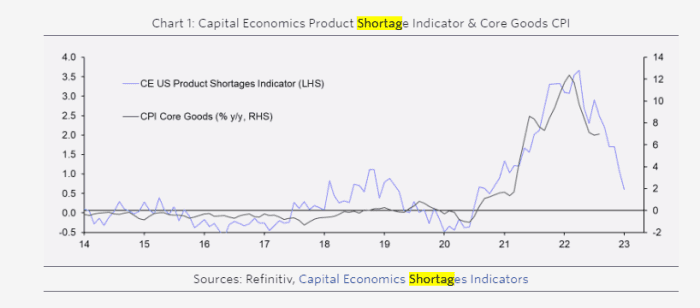[ad_1]
Signs of disinflation have emerged even as investors fear Federal Reserve Chair Powell and his colleagues will keep battling inflation through aggressive rate hikes that have hurt both stocks and bonds, according to a Capital Economics note.
While it appears the Fed may on Wednesday announce that it’s hiking its benchmark rate by three quarters of a percentage point for a third straight time, Paul Ashworth, chief North America economist at Capital Economics, expects a less aggressive monetary policy stance could soon follow.
“If we’re right that inflation will fall back soon, officials will quickly pivot to much smaller hikes,” he said in a note Tuesday. “The continued drop in gasoline prices and easing food inflation will weigh on headline CPI over the next month or two,” he said, referring to the consumer-price index. He also pointed to signs of disinflation in core CPI data, which exclude energy and food.
“Despite the larger than expected 0.6% rise in core prices in August, there are mounting signs of disinflation there too,” he wrote. Supply shortages have normalized, with the firm’s product shortages indicator now suggesting that “core goods inflation could fall back to 2% before the end of the year, from 7% in August,” according to Ashworth.

CAPITAL ECONOMICS NOTE DATED SEPT. 20, 2022
The Federal Reserve is aiming to bring inflation down to its 2% target range through monetary tightening that got under way earlier this year, crushing stocks and bonds.
The U.S. stock market closed lower Tuesday, as investors await clues on the Fed’s future path of rate hikes after it concludes its two-day policy meeting Wednesday.
The Dow Jones Industrial Average
DJIA,
fell 1% Tuesday, while the S&P 500
SPX,
dropped 1.1% and the Nasdaq Composite
COMP,
slid almost 1%, according to FactSet data.
The fed-funds rate sits at a range of 2.25% to 2.5% ahead of the central bank’s anticipated rate increase Wednesday. Fed funds futures suggest the rate may peak at close to 4.5%, according to the Capital Economics note.
“Those expectations are above our own forecasts, principally because we expect inflation to drop back more markedly,” said Ashworth. Core services inflation is being fueled by rapidly increasing rents, “but the latest private sector measures suggest that inflation for new leases is slowing markedly,” he said.
In his view, a “disinflationary wave is building.”
“There are broader signs of deflation in services from falling airfares to hotel rates, while the plunge in longer-term inflation expectations has markedly reduced the risks of a price-wage spiral,” he said. “The upshot is that we expect to see clearer and more convincing signs of a drop back in inflation in the CPI figures soon.”
Meanwhile, higher real yields are weighing on stock prices and pushing corporate bond spreads higher, his note shows.
For example, the ICE BofA U.S. High Yield Index Option-Adjusted Spread index was 4.88 percentage points over comparable Treasurys on Monday, up from 4.2 percentage points on Aug. 11, according to data on the Federal Reserve Bank of St. Louis’s website.
Shares of the iShares Boxx $ High Yield Corporate Bond ETF
HYG,
fell around 1% Tuesday, FactSet data show. The fund has lost 11.6% this year on a total return basis through Monday.
See: Why rising Treasury yields are plaguing the stock market ahead of Fed’s next rate increase
[ad_2]
Source link
